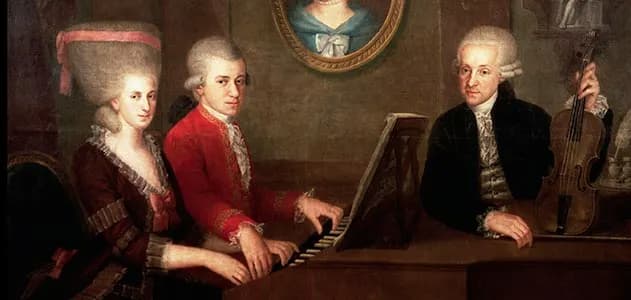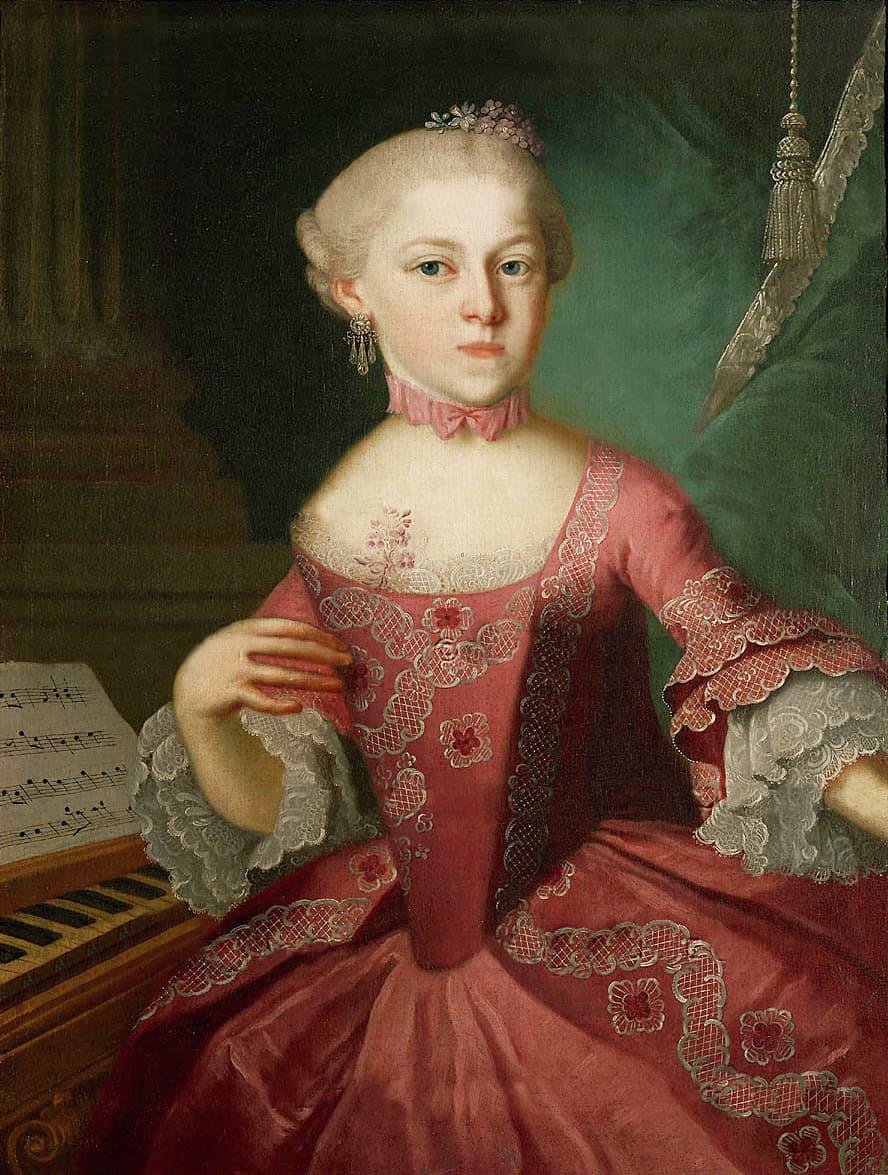Maria Anna Mozart, known to her family as Nannerl, is one of the great what-ifs of music history. She was the sister of Wolfgang Amadeus Mozart, an inspiration and constant companion to him, one of her generation’s great piano prodigies, and more. Her potential, it seems, was limitless.

Nannerl and Wolfgang playing the piano together © The Art Archive / Corbis
In the end, thanks to the constrictions of eighteenth-century gender norms, it became impossible for her to totally fulfill her musical potential. Even so, despite those constrictions, she accomplished a great deal over the course of her career. She’s also responsible for much of what we know about her brother today.
She’s a figure worth getting to know, so here are thirteen facts about the fascinating, bittersweet life of Maria Anna Mozart:
1. Maria Anna Walburga Ignatia Mozart – later nicknamed Nannerl – was born to Leopold and Anna Maria Mozart in July 1751 in Salzburg.
2. In January 1756, when she was four years old, a little brother arrived. His name was Wolfgang Amadeus. When she was around seven or eight years old, her father began teaching her harpsichord. Her nosy little brother was fascinated, and soon he became involved with the family music-making, in awe of his big sister’s talent, soaking it up like a sponge. Soon he was being given lessons of his own.
3. Later in life, Maria Anna would become an important source of knowledge about Wolfgang’s early days. “The boy immediately showed his extraordinary, God-given talent,” she once wrote. “He often spent long periods at the clavier, picking out thirds, and his pleasure showed that they sounded good to him… When he was five years old he was composing little pieces which he would play to his father who would write them down.”
Mozart’s first compositions
4. In 1762, the year Maria Anna turned nine and Wolfgang six, their father Leopold decided to take his talented offspring on the road in search of fame, influence, and fortune. So they embarked upon an extraordinary European tour that lasted for three years. Consequently, they spent their most formative years together and separated from other children, with only each other to understand what they were each going through.
5. Together they visited the capitals of Europe, charming monarchs, and the aristocracy. In Vienna in 1762, they met the future Marie Antoinette, who had been born in 1755. Legend has it that Wolfgang fell on the floor while playing with her, she helped him up, and he proposed to her.
6. In 1764 Leopold fell very ill during a stay in London, and the children had to be quiet while he rested and recovered. “Resting” and “being quiet” ended up being an excuse for Wolfgang to start writing down his first symphony, with Maria Anna’s input. This was the year he turned eight and Maria Anna thirteen.
Mozart: Symphony no. 1, San Francisco Academy Orchestra, Andrei Gorbatenko
7. They returned home to Salzburg in 1766. The following year the family moved to Vienna, where they stayed until 1769. That was the year Maria Anna turned eighteen. She could no longer appear as a child prodigy, and there would have been pressure to marry: the easiest route to economic security for a woman. Meanwhile, Wolfgang and Leopold set off on multiple expensive trips to Italy. During this time, she helped contribute financially to the family by teaching, a job she loved doing.
8. When she was around thirty, she apparently fell in love with a captain named Franz d’Ippold. Wolfgang liked him, or at least was unopposed to the match. He wrote to her suggesting that she gets married and come join him in Vienna. “If it works, you could certainly get married; in fact, believe me, you too could earn a fair amount here in Vienna, for example playing in private concerts and giving lessons. You would be in demand and well paid,” he wrote in 1781. However, she stayed put, and she never married d’Ippold.

Maria Anna Walburga Ignatia Mozart by Pietro Antonio Lorenzoni
© madamegilflurt.com
9. In 1784, at the age of thirty-three, she married a wealthy widower twice her age named Baron Johann Baptist von Berchtold zu Sonnenburg and moved with him to his rural home. She helped raise his five children and also had three biological children of her own in 1785, 1789, and 1790. For reasons that are still unclear to us today, she left her firstborn son in the care of her father. The Baron’s wealth allowed her to pursue her musical interests, allowing her to play the keyboard for up to several hours a day.
10. Initially, Wolfgang and Maria Anna remained close. He sent her manuscripts of his music, including his piano concertos. It’s possible she may even have given the Salzburg premieres of some of his piano concertos. But their radically different lives, and perhaps the radically different choices they’d made, led them to drift apart. They met for the last time in 1783, when Wolfgang visited Salzburg with his new wife. They stopped writing to each other altogether in 1788. Mozart died in 1791.
11. Maria Anna read a biography of her dead brother sometime around 1800. She wrote of the experience, “Herr Prof. Niemetschek’s biography so completely reanimated my sisterly feelings toward my so ardently beloved brother that I was often dissolved in tears since it is only now that I became acquainted with the sad condition in which my brother found himself.”
12. Her husband died ten years after her brother, in 1801. Afterwards, she returned to Salzburg with her children to teach piano, an occupation she chose to pursue despite the fact it was no longer a financial necessity for her. Mozart’s wife Constanze and her second husband – a Mozart biographer – came to visit her in the 1820s. Their relationship was never close, but Maria Anna did offer Constanze and her husband historically valuable family correspondence from their childhood.
13. Her health declined in her old age, and by 1825 she was blind. One late visitor called her “blind, languid, exhausted, feeble, and nearly speechless.” Unlike her brother, thanks to her marriage, she died a wealthy woman. She died on 29 October 1829 at the age of seventy-eight in Salzburg, forever one of the great question marks in music history.
For more of the best in classical music, sign up for our E-Newsletter
